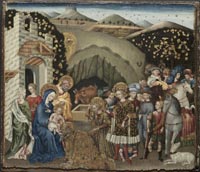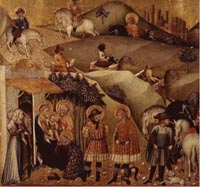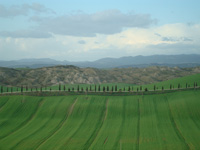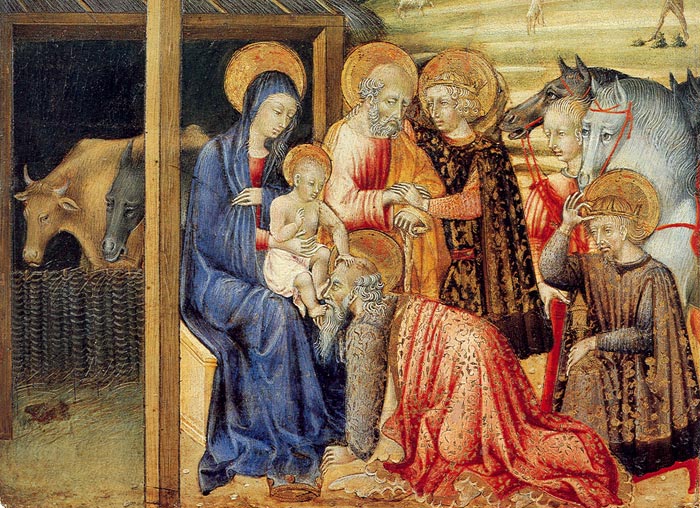 |
Giovanni di Paolo, Adoration of the Magi (detail), about 1450-1460, tempera and gold on panel, 27 x 23.2 cm, New York, Metropolitan Museum of Art |
Giovanni di Paolo | Adoration of the Magi, about 1450-1460 |
| Giovanni di Paolo di Grazia (ca. 1403 - ca. 1483), one of the most important Italian painters of the 15th-century Sienese school. He is chiefly notable for carrying the brilliantly colourful vision of Sienese 14th-century paintings on into the Renaissance. His early works show the influence of previous Sienese masters, his landscapes and his figures still reverberate with echoes of Duccio's work, but his later style grew steadily more individualized, characterized by vigorous, harsh colors and elongated forms. His art most beautifully reflects the 15th-century artistic conservatism of a commercially declining city.[1] The Adoration of the Magi According to the Gospel of Matthew, three Magi, guided by a star, found the newborn Christ and laid gifts before him. Artists throughout the 15th century considerably elaborated upon this biblical account, devoting particular attention on the Magi's entourage, which gave them an opportunity to depict the splendor of contemporary aristocratic life. Here, the Magi supplicate solemnly before the divine child in the Virgin's arms, while their bustling retinue of courtiers and animals provides an exuberant visual diversion. Giovanni's brilliant color and pattern were typically Sienese, but he is distinguished from his teachers and contemporaries by an expressive imagination. His unique style is otherworldly and spiritual. Here the drama is heightened by a dark background and contrasting colors, nervous patterns, and unreal proportions. In the center, Gabriel brings news of Christ's future birth to the Virgin. Thus is put in motion the promise of salvation for humankind, a salvation necessitated by the expulsion of Adam and Eve from Paradise, which we see happening on the left, outside Mary's jewellike home. Mary will reopen the doors of Paradise closed by Eve's sin. The scene of Joseph warming himself in front of a fire, on the right, is an unusual addition. Perhaps it refers simply to the season of Jesus' birth, but more likely it is layered with other meanings, suggesting the flames of hope and charity and invoking the winter of sin now to be replaced by the spring of this new era of Grace. The three scenes help make explicit the connection between the Fall and God's promise of salvation, which is fulfilled at the moment of the Annunication. |
| Trained in Siena, Giovanni di Paolo was heir to a long tradition of famous painters who worked in the city. The artist borrowed heavily from his contemporaries in creating his own highly personal and graceful style. Giovanni di Paolo depicts the arrival of the Magi at Bethlehem in a wealth of color and detail befitting the riches they brought the Christ Child. The Magi pay homage to Christ as he sits on the Virgin's lap beneath a blazing, golden star. Crowns, sumptuous robes, a crowd of servants (one sprawling to remove the spurs of the standing king), and even a pet monkey stress the wealth and power of the visitors. The visit of the Magi is described in the Book of Matthew as the epiphany, when the arrival of Christ became known to the world. Magi are literally astrologers, but over the centuries, popular legends transformed them into kings and they are usually shown in royal robes and crowns. | ||
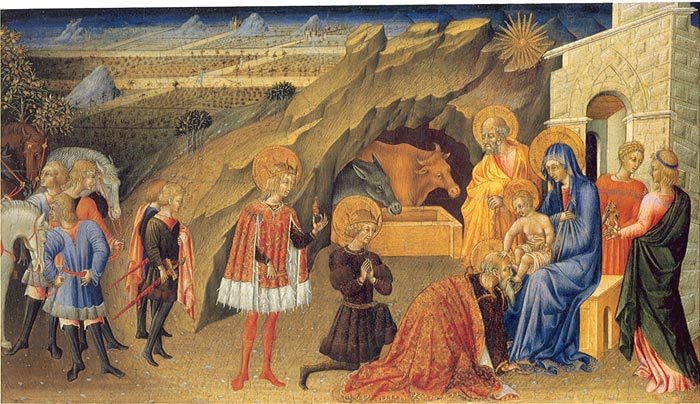 |
||
Giovanni di Paolo, Adoration of the Magi , about 1450, tempera on panel, 26.9 x 46.4 cm, Washington, National Gallery of Art |
||
| This Adoration of the Magi panel is the latest of four known depictions of the subject by the artist. The other three are in the Rijksmuseum Kröller-Müller, Otterlo, the Cleveland Museum of Art, and the National Gallery of Art, Washington. Giovanni di Paolo's brilliant color and pattern were typically Sienese, but he is distinguished from his teachers and contemporaries by an expressive imagination. His unique style is otherworldly and spiritual. Though Giovanni's primary concern is not the appearance of the natural world, it is clear that he was aware of contemporary developments in the realistic depiction of space. This panel originally formed part of the predella of an altarpiece, along with a "Nativity" (Fogg Art Museum, Cambridge, Massachusetts), an "Infant Christ Disputing in the Temple" (Isabella Stewart Gardner Museum, Boston), and possibly a "Crucifixion" (Christ Church, Oxford). The central panel of the altarpiece may have been the "Presentation of Christ in the Temple" formerly in the Conservatorio di S. Pietro at Colle di Val d'Elsa and now in the Pinacoteca Nazionale, Siena. Art in Tuscany | Giovanni di Paolo | The Annunciation and Expulsion from Paradise |
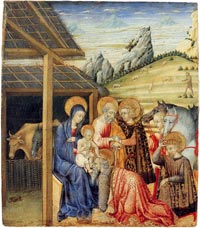 Giovanni di Paolo, Adoration of the Magi, about 1450-1460, New York, Metropolitan Museum of Art |
|
|
||
Siena is in fact surrounded by the Chianti hills (north-east), the Montagnola (west) and the Crete Senesi (south-east). |
||||
Holiday accomodation in Tuscany | Podere Santa Pia | Artist and writer's residency
|
||||
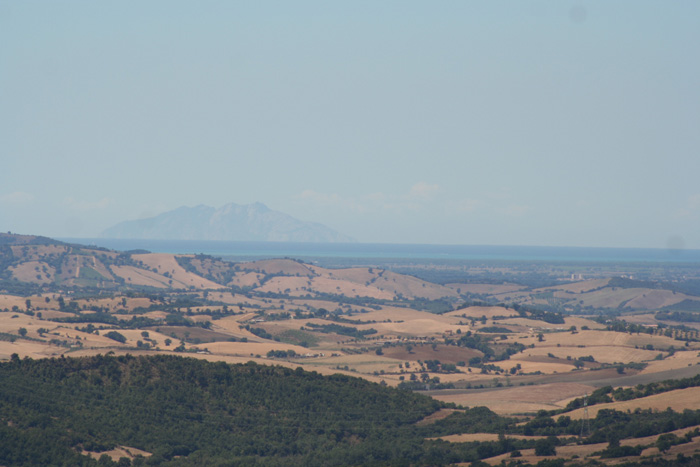 |
||||
Podere Santa Pia is situated in the unspoiled valley of the Ombrone River, only 21 kilometres from Montalcino. This valley is famous locally as being of great natural beauty and still very undeveloped. |
||||
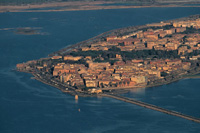 |
||||
Podere Santa Pia |
Podere Santa Pia, garden view, December |
Orbetello | ||
 |
 |
|||
| The towers of San Gimignano | Montalcino |
Siena, Duomo |
||
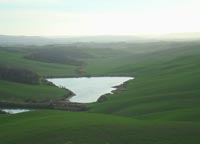 |
||||
Asciano, between Montalcino and Siena |
Pienza |
The Val d'Orcia and the Crete Senesi |
||
| On the hill of Vespignano, near Vicchio, stands the house which saw the birth of Angiolo di Bondone, better known as Giotto. After lengthy restoration works the Casa di Giotto is re-opening to the public in its new guise. The operation put in hand by the commune of Vicchio has been aimed above all at making this ancient country dwelling into a centre of knowledge and an incentive in art in the present day. To attain this end the space has been divided ideally into 4 large areas: reception, Giotto and the Territory on the ground floor, with workshops occupying the spaces on the upper storey. The life of Giotto is related on a video, while interactive multimedia points will serve to supply additional information on matters connected with the artist, according to the interests of the individual visitor. As regards the territory, the interior/exterior relationship with the surrounding country will be particularly stressed, and here also a number of videos will be used as an aid to understanding. On the upper floor are two spaces for workshops, one devoted to form, the other to colour. It will be a place of experiment, in which visitors, be they school parties, families or artists, will be encouraged to play and create. The Casa di Giotto intends in particular to establish itself as a destination for educational excursions for primary to secondary schools. |
||||

